Weld Formation, Microstructure Evolution and Mechanical Property of Laser-Arc Hybrid Welded AZ31B Magnesium Alloy
Abstract
:1. Introduction
2. Materials and Methods
3. Results and Discussions
3.1. Comparison of Welding Processes
3.2. Weld Formation for Laser-Arc Hybrid Welding
3.2.1. Macro-Morphologies of the Surface and Cross-Sectional Weld
3.2.2. Relationship between Heat Input and Weld Formation
3.3. Microstructure Evolutions
3.4. Weld Tensile Properties
4. Conclusions
- A large penetration depth and sound weld formation of Mg alloys can be obtained by laser-arc hybrid welding. The undercut defect can be inhibited by the filling of wires, while the pores can be eliminated by the large volume and slow cooling rate of the molten pool.
- The penetration depth and width were not significantly related to the total heat input, but showed a linear relation with the laser heat input and arc heat input, respectively.
- The grain size of the equiaxed grains was closely related to the heat input. The higher the heat input was, the lower the cooling rate of the molten pool, which induced adequate time for growth of the grains.
- The tensile strength and elongation rate decreased with an increase in laser energy or arc energy, which also deteriorated at a high welding speed because of a lack of filling. Many cracks occurred at the fracture surface with excessive power or insufficient filling. The optimized welding parameters were a laser power of 3.5 kW, welding speed of 1.8 m/min and welding current of 100 A. In this case, the tensile strength and elongation rate reached 190 MPa and 12%, respectively.
Author Contributions
Funding
Institutional Review Board Statement
Informed Consent Statement
Data Availability Statement
Acknowledgments
Conflicts of Interest
References
- Li, Y.; Qin, F.; Liu, C.; Wu, Z. A Review: Effect of Friction Stir Welding on Microstructure and Mechanical Properties of Magnesium Alloys. Metals 2017, 7, 524. [Google Scholar] [CrossRef] [Green Version]
- Khokhlova, J.; Khokhlov, M.; Synyuk, V.; Khokhlova, Y. Magnesium alloy AZ63A reinforcement by alloying with gallium and using high-disperse ZrO2 particles. J. Magnes. Alloy 2016, 4, 265–269. [Google Scholar] [CrossRef] [Green Version]
- Harooni, M.; Carlson, B.; Kovacevic, R. Dual-beam laser welding of AZ31B magnesium alloy in zero-gap lap joint configuration. Opt. Laser Technol. 2014, 56, 247–255. [Google Scholar] [CrossRef]
- Singh, K.; Singh, G.; Singh, H. Microstructure and mechanical behaviour of friction-stir-welded magnesium alloys: As-Welded and post weld heat treated. Mater. Today Commun. 2019, 20, 100600. [Google Scholar] [CrossRef]
- Singh, K.; Singh, G.; Singh, H. Investigation of microstructure and mechanical properties of friction stir welded AZ61 magnesium alloy joint. J. Magnes. Alloy 2018, 6, 292–298. [Google Scholar] [CrossRef]
- Kumar, S.D. Effect of heat treatment conditions on ballistic behaviour of various zones of friction stir welded magnesium alloy joints. Trans. Nonferrous Met. Soc. China 2021, 31, 156–166. [Google Scholar] [CrossRef]
- Çam, G.; Javaheri, V.; Heidarzadeh, A. Advances in FSW and FSSW of dissimilar Al-alloy plates. J. Adhes. Sci. Technol. 2022, 1–33. [Google Scholar] [CrossRef]
- Çam, G.; Ipekoglu, G. Recent developments in joining of aluminium alloys. Int. J Adv. Manuf. Technol. 2017, 91, 1851–1866. [Google Scholar] [CrossRef]
- Ipekoglu, G.; Cam, G. Formation of weld defects in cold metal transfer arc welded 7075-T6 plates and its effect on joint performance. IOP Conf. Ser. Mater. Sci. Eng. 2019, 629, 012007. [Google Scholar] [CrossRef]
- Çam, G.; Ventzke, V.; Dos Santos, J.; Koçak, M.; Jennequin, G.; Gonthier-Maurin, P. Characterisation of electron beam welded aluminium alloys. Sci. Technol. Weld. Join. 1999, 4, 317–323. [Google Scholar] [CrossRef]
- Kumar, S.; Vigneshwar, M.; Selvamani, S.; Prakash, A.; Hariprasath, P. The Comparative Analysis on Friction Stir Welded and Gas Tungsten Arc Welded AZ91 Grade Magnesium Alloy Butt Joints. Mater. Today Proc. 2017, 4, 6688–6696. [Google Scholar] [CrossRef]
- Subravel, V.; Alagappan, N.; Babu, N. Influence of arc oscillation frequency on tensile properties and microstructural characteristics of magnetic arc oscillation welded AZ31B magnesium alloy joints. Mater. Today Proc. 2020, 22, 606–613. [Google Scholar] [CrossRef]
- Wang, Z.; Feng, Y.; Feng, R.; Tang, S. Full digital multi-function square wave welding inverter based on ARM. Trans. Weld. Inst. 2014, 35, 33–36. [Google Scholar]
- Sahul, M.; Sahul, M.; Lokaj, J. Effect of Surface Layer on the Properties of AZ31 Magnesium Alloy Welded Joints. Mater. Today Proceed. 2016, 3, 1150–1155. [Google Scholar] [CrossRef]
- Boughanmi, C.; Mhiri, H.; Bournot, P. Numerical Analysis of a Coaxial Impingement Jet and Application for a Laser Welding of AZ91 Magnesium Alloy with Shielding Gas. Energy Procedia 2017, 107, 237–241. [Google Scholar] [CrossRef]
- Çam, G.; Koçak, M. Progress in joining of advanced materials. Int. Mater. Rev. 1998, 43, 1–44. [Google Scholar] [CrossRef]
- Lei, Z.; Bi, J.; Li, P.; Li, Q.; Chen, Y.; Zhang, D. Melt flow and grain refining in ultrasonic vibration assisted laser welding process of AZ31B magnesium alloy. Opt. Laser Technol. 2018, 108, 409–417. [Google Scholar] [CrossRef]
- Wahba, M.; Mizutani, M.; Kawahito, Y.; Katayama, S. Laser welding of die-cast AZ91D magnesium alloy. Mater. Des. 2012, 33, 569–576. [Google Scholar] [CrossRef]
- Chen, X.; Yu, G.; He, X.; Li, S. Investigation of thermal dynamics for different leading configuration in hybrid laser-MIG welding. Opt. Laser Technol. 2020, 134, 106567. [Google Scholar] [CrossRef]
- Bunaziv, I.; Wenner, S.; Ren, X.; Frostevarg, J.; Kaplan, A.F.; Akselsen, O.M. Filler metal distribution and processing stability in laser-arc hybrid welding of thick HSLA steel. J. Manuf. Process. 2020, 54, 228–239. [Google Scholar] [CrossRef]
- Bunaziv, I.; Frostevarg, J.; Akselsen, O.M.; Kaplan, A.F. Process stability during fiber laser-arc hybrid welding of thick steel plates. Opt. Lasers Eng. 2017, 102, 34–44. [Google Scholar] [CrossRef]
- Song, G.; Diao, Z.; Lv, X.; Liu, L. TIG and laser–TIG hybrid filler wire welding of casting and wrought dissimilar magnesium alloy. J. Manuf. Process. 2018, 34, 204–214. [Google Scholar] [CrossRef]
- Gao, M.; Tang, H.-G.; Chen, X.-F.; Zeng, X.-Y. High power fiber laser arc hybrid welding of AZ31B magnesium alloy. Mater. Des. 2012, 42, 46–54. [Google Scholar] [CrossRef]
- Meng, Y.; Gao, M.; Zeng, X. Quantitative analysis of synergic effects during laser-arc hybrid welding of AZ31 magnesium alloy. Opt. Lasers Eng. 2018, 111, 183–192. [Google Scholar] [CrossRef]
- Hao, K.; Zhang, C.; Zeng, X.; Gao, M. Effect of heat input on weld microstructure and toughness of laser-arc hybrid welding of martensitic stainless steel. J. Mater. Process. Technol. 2017, 245, 7–14. [Google Scholar] [CrossRef]
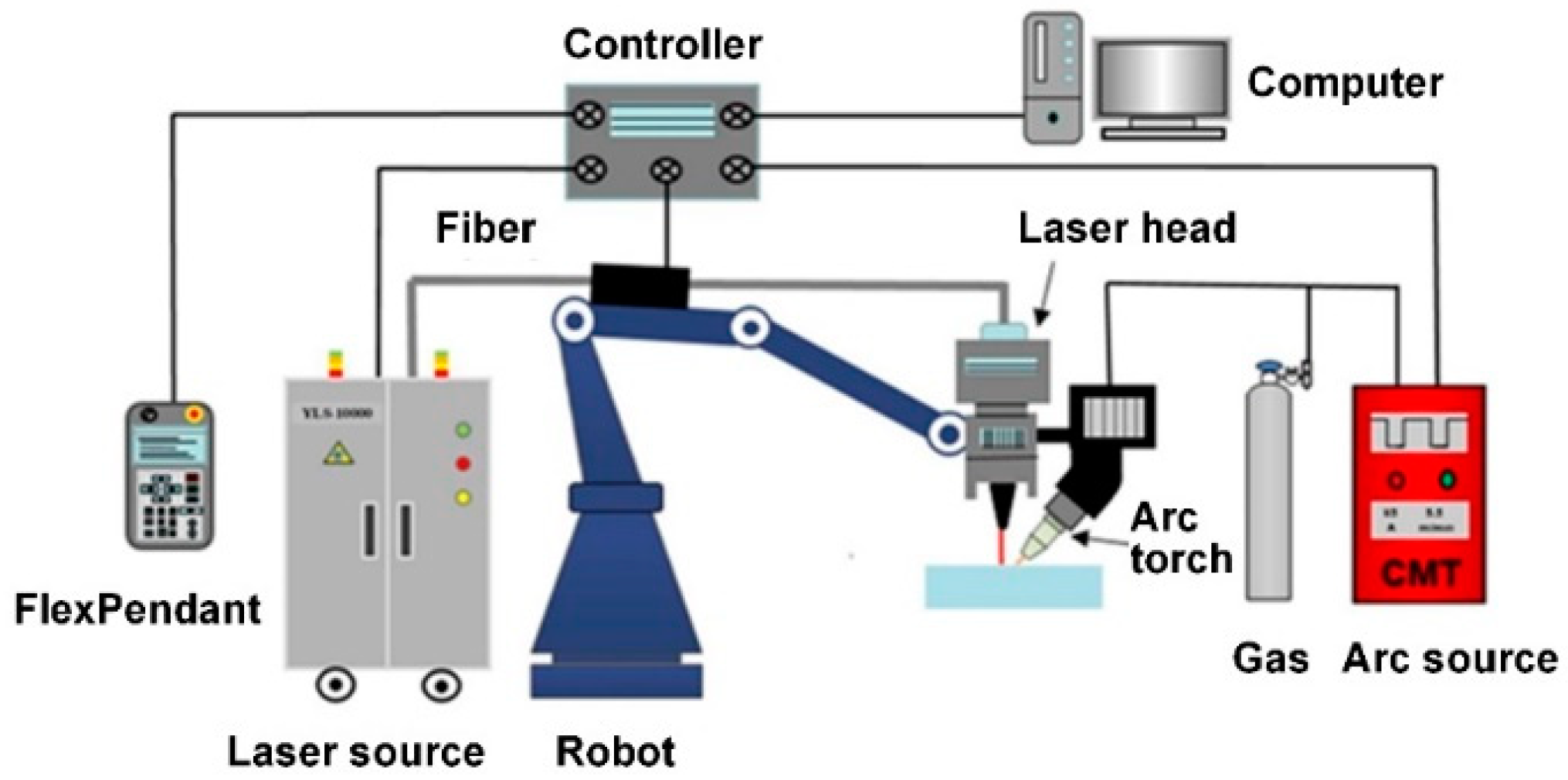


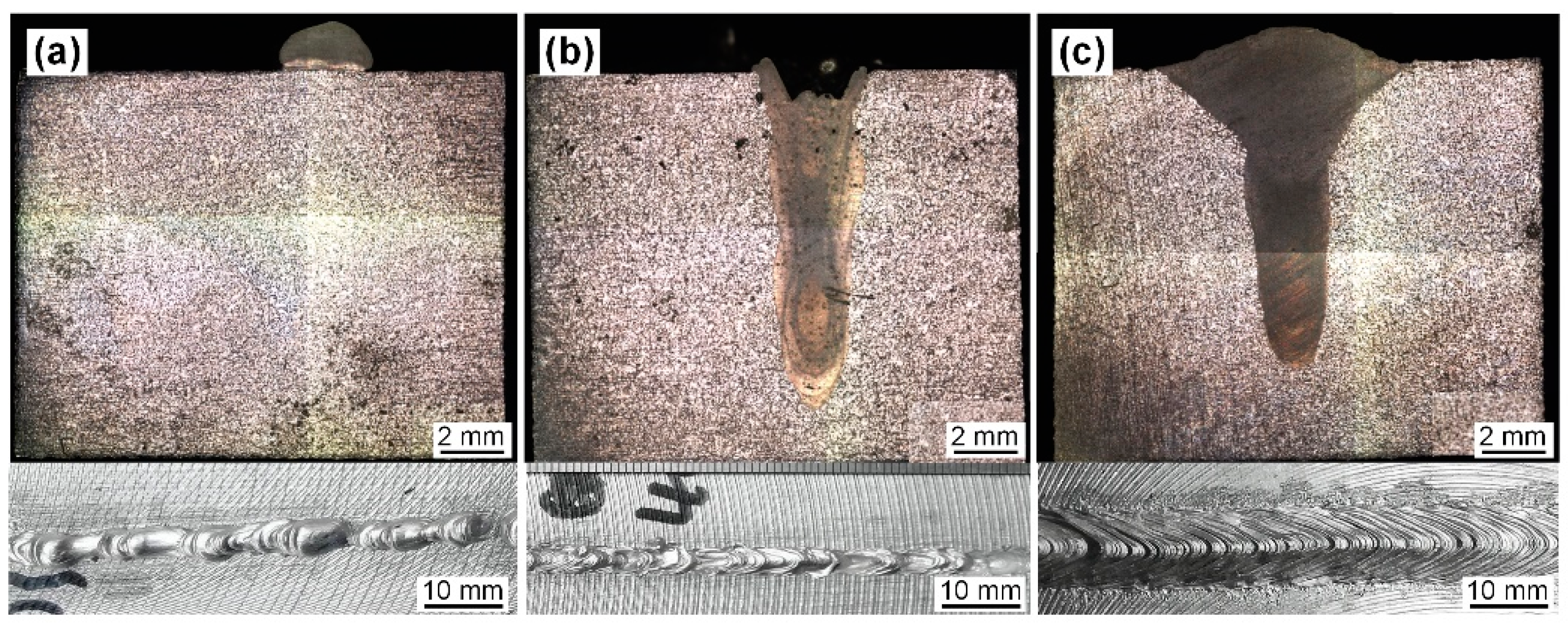
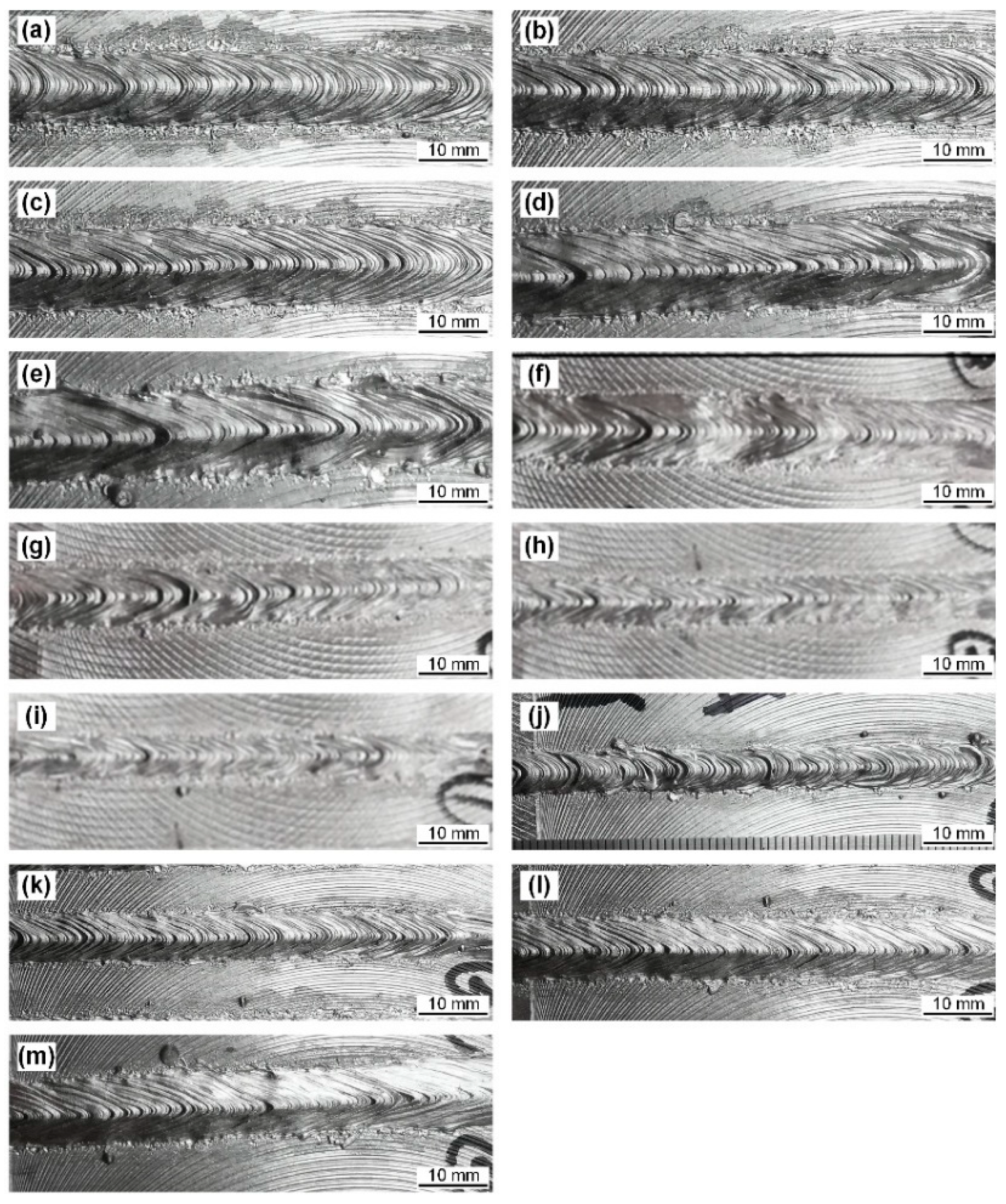


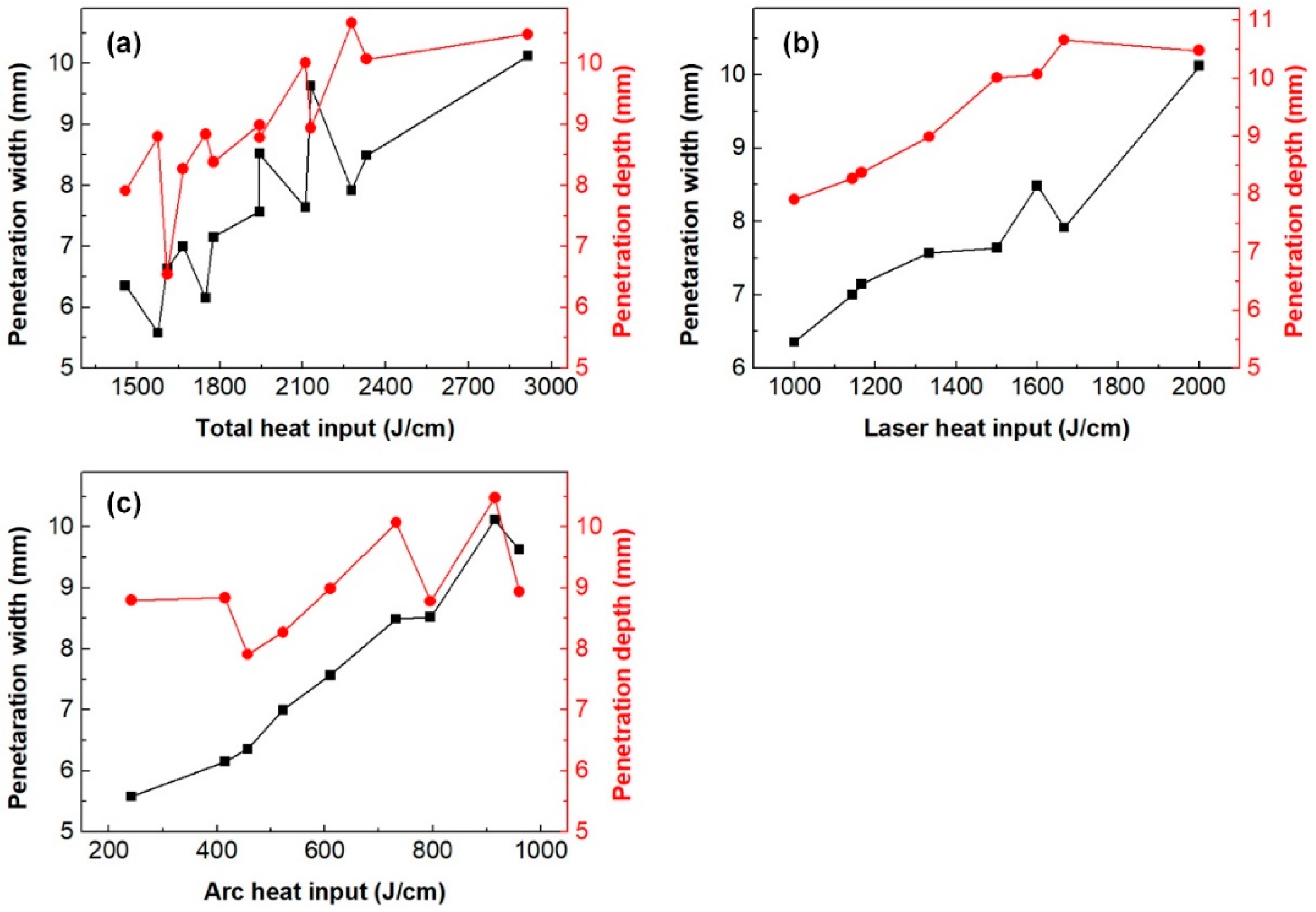
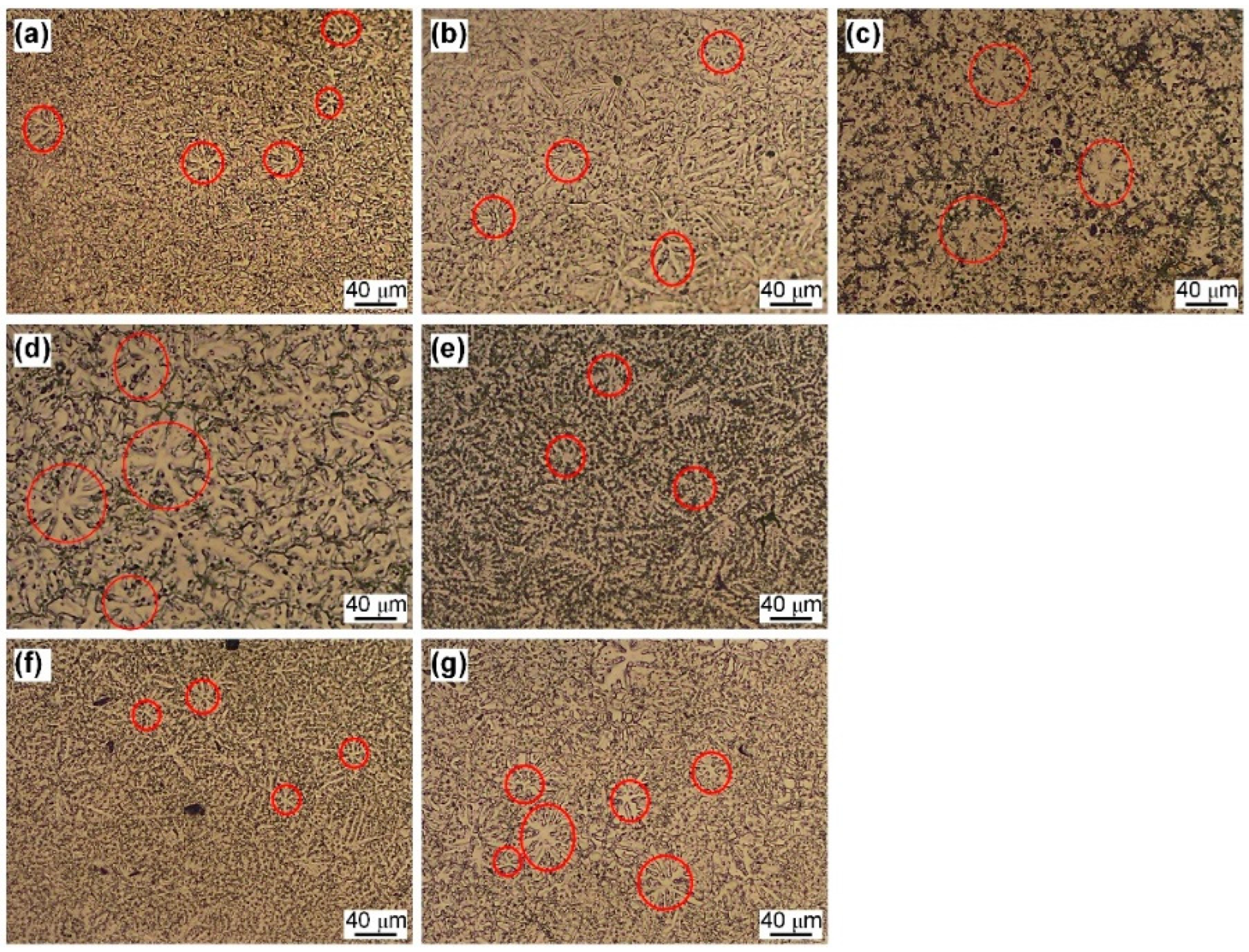

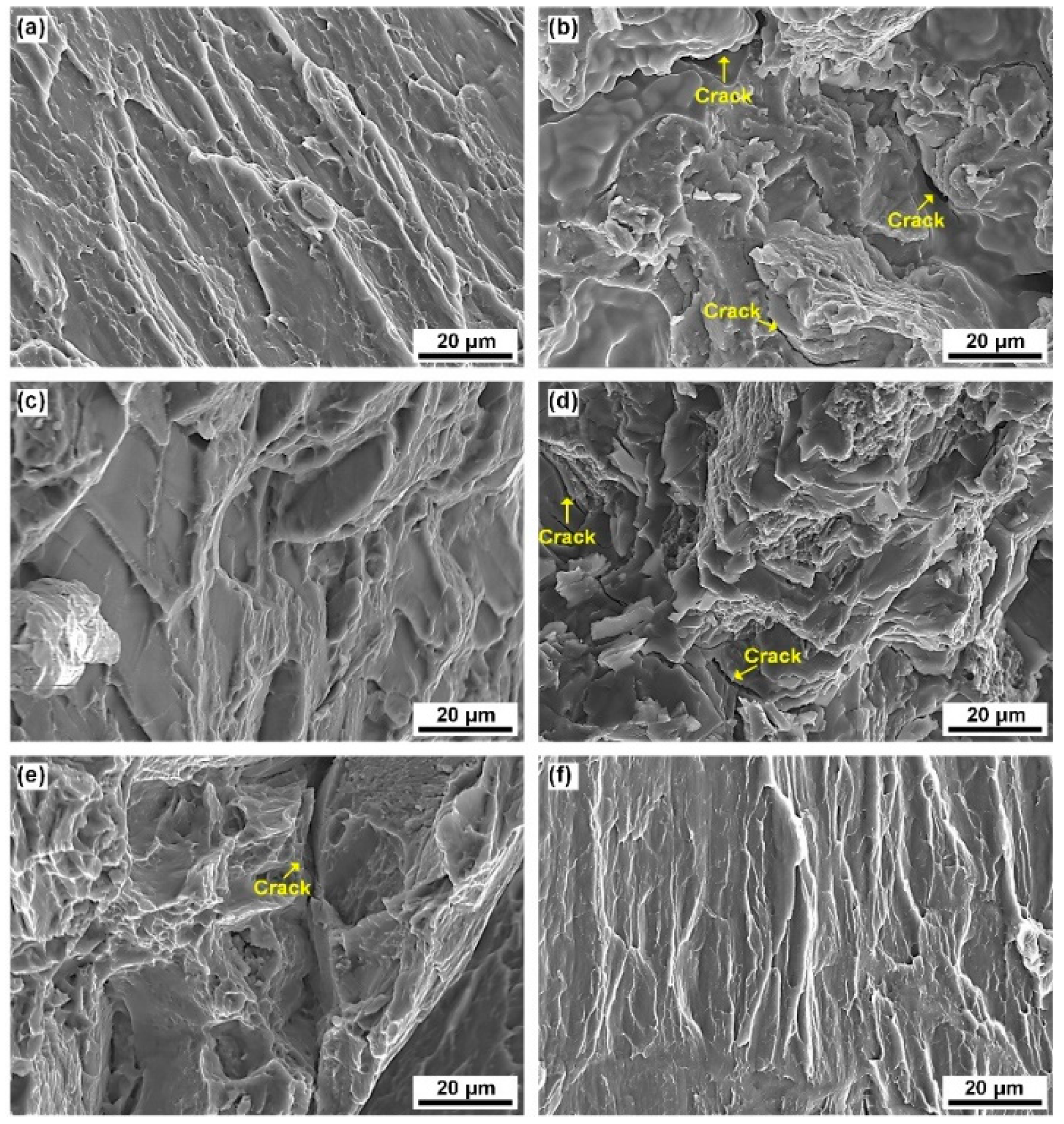
| Al | Zn | Mn | Si | Fe | Cu | Ni | Ca | Mg |
|---|---|---|---|---|---|---|---|---|
| 2.5–3.5 | 0.6–1.4 | 0.2–1.0 | 0.08 | 0.003 | 0.01 | 0.001 | 0.04 | Bal. |
| Laser Power, P (kW) | Welding Speed, v (m/min) | Welding Current, I (A) | |
|---|---|---|---|
| Arc welding | / | 1.8 | 100 |
| Laser welding | 4 | 1.8 | / |
| #1 | #2 | #3 | #4 | #5 | #6 | #7 | #8 | #9 | #10 | #11 | #12 | #13 | |
|---|---|---|---|---|---|---|---|---|---|---|---|---|---|
| P | 3 | 3.5 | 4 | 4.5 | 5 | 4 | 4 | 4 | 4 | 4 | 4 | 4 | 4 |
| v | 1.8 | 1.8 | 1.8 | 1.8 | 1.8 | 1.2 | 1.5 | 2.1 | 2.4 | 1.8 | 1.8 | 1.8 | 1.8 |
| I | 100 | 100 | 100 | 100 | 100 | 100 | 100 | 100 | 100 | 50 | 75 | 125 | 150 |
Publisher’s Note: MDPI stays neutral with regard to jurisdictional claims in published maps and institutional affiliations. |
© 2022 by the authors. Licensee MDPI, Basel, Switzerland. This article is an open access article distributed under the terms and conditions of the Creative Commons Attribution (CC BY) license (https://creativecommons.org/licenses/by/4.0/).
Share and Cite
Wang, S.; Yan, C.; Gu, Z. Weld Formation, Microstructure Evolution and Mechanical Property of Laser-Arc Hybrid Welded AZ31B Magnesium Alloy. Metals 2022, 12, 696. https://doi.org/10.3390/met12040696
Wang S, Yan C, Gu Z. Weld Formation, Microstructure Evolution and Mechanical Property of Laser-Arc Hybrid Welded AZ31B Magnesium Alloy. Metals. 2022; 12(4):696. https://doi.org/10.3390/met12040696
Chicago/Turabian StyleWang, Sibo, Chunyan Yan, and Zhengjia Gu. 2022. "Weld Formation, Microstructure Evolution and Mechanical Property of Laser-Arc Hybrid Welded AZ31B Magnesium Alloy" Metals 12, no. 4: 696. https://doi.org/10.3390/met12040696





